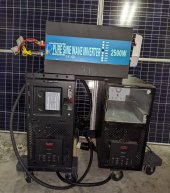I have found the EG4 6500EX when running well under the rated capacity with a small inductive load such as a freezer, the inverter can not hold output voltage steady, thus leading to the flickering lights problem. Output voltage will swing from 111V to 128V.
The big question is the inverter faulty, or can it be fixed with firmware or are you saying that any HF inverter can't run a small inductive load? I don't believe the latter to be true, I don't see the problem running a 240V well pump for example that is a large inductive load.
I went back and looked at
@SignatureSolarJames waveform and how it was only a led light and resistive load. Is that a true representation of household usage? Hardly, there are many inductive loads from freezers, refrigerators, blow dryers, well pumps, heat pumps, etc. Why would a company only post up a waveform with a resistive load instead of an inductive load?
The light flicker problem is inverter output voltage related. Either defective hardware or firmware. If the LV6548 does not suffer from this problem, the EG4 6500EX should not also unless to get the price down, certain elements were substituted. Or it has to do with the increase in PV voltage limit, if so the LV6548V should have light flicker. Time will certainly tell.



